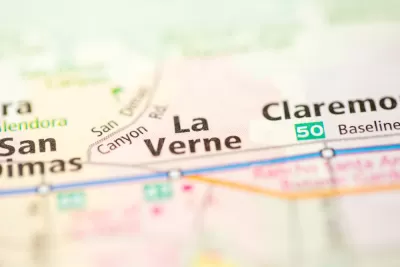La Verne is the first city in Los Angeles County, and one of the first in the state, to implement an Enhanced Infrastructure Financing District, designed to generate a source of funding to replace the loss of redevelopment funds during the recession.

Joe Mathews reports from La Verne, a small city of about 32,000 residents located on the eastern edge of Los Angeles County that has taken on a massive experiment in the state of California.
That’s because this city — for its own reasons — has formed one of California’s first EIFDs. The acronym stands for enhanced infrastructure financing district, a new government entity that the Legislature has championed for addressing California’s massive housing shortage and infrastructure deficit.
But EIFDs are unproven, and only a handful of California places have established them. In fact, EIFDs are a much weaker tool than the redevelopment agencies that localities relied upon for major projects before 2012, when redevelopment was eliminated because the agencies grabbed revenues that otherwise would have gone to schools.
EIFDs work similarly — designate a certain area for improvement and then capture the increased tax receipts — but state lawmakers put limits on their ability to take revenues from other taxing entities.
La Verne is deploying the EIFD in anticipation of a forthcoming light rail station connecting to the Los Angeles County Metropolitan Transportation Authority's Gold Line, expected to open in 2026. La Verne has a bustling "Old Town" district, is home to the University of La Verne, and is located next door to the Fairplex facility which hosts the county fair and other large events throughout the year. La Verne was also hit hard by the foreclosure crisis of the Great Recession and subject to affordability concerns like most California communities in large metropolitan areas in 2019.
According to Mathews, other parts of the state are eager to see the results of La Verne's experimentation to consider EIFDs connected to large projects like the restoration of the Los Angeles River or the extension of BART through San Jose.
Planetizen blogger Linda Day wrote a detailed explanation of EIFDs back in 2016.
FULL STORY: How one small city could show way for California housing challenge

Planetizen Federal Action Tracker
A weekly monitor of how Trump’s orders and actions are impacting planners and planning in America.

San Francisco's School District Spent $105M To Build Affordable Housing for Teachers — And That's Just the Beginning
SFUSD joins a growing list of school districts using their land holdings to address housing affordability challenges faced by their own employees.

The Tiny, Adorable $7,000 Car Turning Japan Onto EVs
The single seat Mibot charges from a regular plug as quickly as an iPad, and is about half the price of an average EV.

Seattle's Plan for Adopting Driverless Cars
Equity, safety, accessibility and affordability are front of mind as the city prepares for robotaxis and other autonomous vehicles.

As Trump Phases Out FEMA, Is It Time to Flee the Floodplains?
With less federal funding available for disaster relief efforts, the need to relocate at-risk communities is more urgent than ever.

With Protected Lanes, 460% More People Commute by Bike
For those needing more ammo, more data proving what we already knew is here.
Urban Design for Planners 1: Software Tools
This six-course series explores essential urban design concepts using open source software and equips planners with the tools they need to participate fully in the urban design process.
Planning for Universal Design
Learn the tools for implementing Universal Design in planning regulations.
Smith Gee Studio
City of Charlotte
City of Camden Redevelopment Agency
City of Astoria
Transportation Research & Education Center (TREC) at Portland State University
US High Speed Rail Association
City of Camden Redevelopment Agency
Municipality of Princeton (NJ)





























